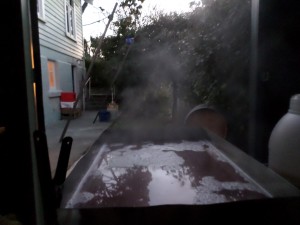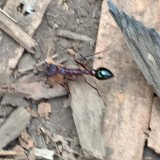Yeast and bacteria are mischievous little creatures and can be found pretty much all around us – in the air and on every surface.
Typically brewers would prefer they weren’t, and in many brewer’s ideal world it would only be the strains they want in the places they want – while bacteria are usually unwanted completely. However, in the last two decades we’ve seen Belgian style-soured ales, such as lambic, and German styles such as gose and berliner weisse, go from being almost a footnote in the history of beer to being sought after globally on an increasingly large scale. These styles can employ a number of methods to pick up wild or natural yeast and bacteria and the brewers and blenders work with the bugs to create unique product; rather than against them to create a sterile environment.

Label from the upcoming Bridge Road/Doctor’s Orders Collaboration. Designed by Matt Burns http://thirst-co.uk
Outside of Belgium and Germany these methods are increasingly influencing brewers to create and experiment with their own local yeast and bacteria. The ever expanding and influential industry in the USA has seen a number brewers use a number of methods to introduce bacteria and wild yeast with the result being unconventional beers that are often tart, sour, and unique to that brewery and their process.
With the influence the American industry has on our local brewers, more Australian and NZ brewers are taking an interest in unconventional fermentation and coming up with their own techniques and methods. At Bridge Road Brewery in Beechworth, they are experimenting with wild yeast from the wine industry, harvesting it from wine barrels and using it to ferment their beer. Founder and brewer Ben Kraus explained their process to me.
“We went and harvested yeast that was spontaneous yeast from the wine industry; spontaneous wine fermentation is pretty common in boutique wineries… we got the cropped yeast from two different wineries, which were naturally occurring yeast, we pitched them into the beer and let that fermentation take off.
They have released two beers in collaboration with New Zealand’s 8 Wired brewery using this method, known as New Bruin Giaconda and Sorrenberg, and their regular Bier De Garde is undergoing the same treatment and is in barrels now. Additionally they are experimenting with wine-must (young wine) fermentation, by pitching their Golden Ale wort (unfermented beer) into barrels with Sangiovese wine-must that had just started showing signs of natural fermentation. Although they don’t have a release date for these new experiments just yet, they expect to leave them for at least a year.
“My experience with tasting barrel aged beers or sour beers from overseas, anything under a year rarely isn’t that good… so we want to leave it for a year.” Ben said.
Some are quite bad, we have one particular barrel that smells just like parmesan cheese. I always thought this one would clear up and become good, but after a couple of years of stench I’m starting to loose faith.
Ben’s collaborator on one of these experiments, Søren Eriksen from 8 Wired Brewery has been doing experiments with natural yeast and bacteria of his own using a few different methods.
“We’ve done this many ways. Sometimes we just fill a couple of barrels straight from the mashtun (no boil) while brewing something else. Other times we fill a couple of barrels after boiling without adding any yeast. Once we have done a full batch, that we boiled as normal, then chilled and left in the open air mashtun over the weekend to collect microbes from the air, then barreled for ferment and ageing,” the owner and brewer said.
Søren believes that while some of the microbes will be coming from the air, there will also be some leftover from the grain as well. Given right now their processes isn’t exact science, their experiments are not always with good result.
“We haven’t done much scientific analysis on these beers but most of them are very sour and will be used as blenders. Some are quite bad, we have one particular barrel that smells just like parmesan cheese. I always thought this one would clear up and become good, but after a couple of years of stench I’m starting to loose faith.”
Like Søren and Ben, the team at Victoria’s 7 Cent brewery have realised that while you can predict the progress of a beer with more conventional yeast strains, it’s not as straightforward when bugs are involved.
“You can start out in your mind with any of your non infected beer and already have a picture of exactly what you want and know sort of 90-95% how to get there but these beers you have absolutely no idea what you’re going to get. You’ll chuck it in there and you’ll just keep sampling it,” said co-founder Brendan Baker.
“We’ve got quite a few barrel beers that we’ve done here and ones we wanted to release earlier that weren’t quite ready yet. It’s purely about sampling every couple of months and seeing how they are tracking,”
The team at 7 Cent started their wild yeast process by naturally collecting microflora from the fruit trees on the farm where the brewery is located. They then proceeded to reuse the harvested yeast and bacteria until they had a flavour profile they were satisfied with.
“We left an open container with wort in it in the orchard when they were blossoming in spring time and captured a heap of the microflora that was around overnight… By about the third ferment it was starting to get quite a nice flavour, so we did a full batch, that one was a turbid mash, a traditional lambic mash, and we threw it into a barrel with the yeast we had cropped and that barrel sat for nine months before we kegged off the first lot. We’ve done another batch of that same beer still using the same yeast. We are going to leave some them for a couple of years and we should get a better understanding of what other flavours we can attribute to the yeast,” Brendan said.
Given Tasmanian brewery Two Metre Tall released their first beer that has been aged for 7 years recently, it seems patience is the only approach when brewing these sorts of beers. You can read about their struggles and journey with these styles of beer in this great Crafty Pint piece published earlier this year.
Also leading local wild experimentation are La Sirène. Based in Alphington (Melbourne) they have likewise showed a lot of that patience in getting their spontaneously fermented beers to market.
Owner and brewer Costa Nikias said that brewing 100% spontaneously fermented beer has been a goal of theirs from the start.
“From the beginning we were always going to head down the path of doing wild fermentation, so it was just a matter of time. What we did was we did two years of pilot trials that were spontaneously fermented various worts under various conditions to see what sort of results we could get. And about 120 brews later we pretty much figured out what’s there in terms of a viable fermentation source, so we did our first 100% spontaneously fermented beer in May this year. We only did that because we got repeatable results at the pilot level for a couple of years before that. “
Throughout their journey to achieving consistency in these hard to tame beers, Costa believes their location in Melbourne has helped get a good balance of yeast and bacteria.
“I think we are lucky because being in an urban area, 9kms from the city, you wouldn’t think there is a huge amount of opportunity to harvest indigenous yeast and bacteria. I think the opposite, I think in urban areas you’ve got more diversity and where our brewery is located, we are bordered by a creek, and bordered on the other side by a national park, so our brewery is directly exposed to this amazing diversity of microflora.”
In Nowra, (NSW), Tim Thomas from HopDog Beerworks says they worked to create an environment for natural yeast to live and thrive by reusing ex-wine barrels and after a few ferments in them, spiking them with brettanomyces yeast.
He hasn’t let lack of orchards and microflora prevent him from building his own sense of place and Tim started this process by brewing a batch of beer and putting it into oak barrels with fresh peaches, where the souring agents came from the barrels and fruit. He then followed that up with a rye IPA which was aged in the same barrels which took on a similar flavour profile. After that they moved to using the barrels entirely for fermentation and starting the process with a sour mash (leaving the grain in the kettle at warm temps to encourage lactobacillus propagation).
“I think for us being in an industrial area, and not near farmland or orchards, old school spontaneous ferments are not an option, but by inoculating and spiking oak barrels to have the characters we want from true wild ferments, we’re getting there. By creating an environment for the right kind of bacteria to develop in, we’re creating a pseudo-natural state for the ferments. “
“I think by adding new beers to these barrels time after time is what’s creating our house funk, and a flavour that we’d never get unless we had coolships and access to local orchards and awesome microflora”.
The kettle souring process that Tim used is increasingly popular in Australia, and is achieved by letting the grain sit in water overnight to create an environment for lactobacillus on the grain to grow. Due to the growth happening before the boiling process, it typically helps create a more stable and predictable beer where more yeast or bacteria can be added once it is boiled. It’s something Ben at Bridge Road has been experimenting with, in collaboration with Darren Robinson from Doctors Orders Brewing for their new Spontaneously Fermented series.
“We did a sour mash – pitched a blended yeast that had lacto and some brett. Then we’ve added fruit bases to the beer before we bottled it. Spontaneous in the mash but the final fermentation was controlled.” Ben said, before adding “one of the guys that works here is giving me shit because it’s not spontaneously fermented.”
Back at La Sirène they have installed a new commercial sized coolship, which is essentially a big open tray that increases the surface area of the cooling beer and aids in some bacteria and yeast collection. All of their pilot trials had been on a smaller sized one.
“We had fabricated a small 100l coolship and we did the trials with that, so the results of that are going to actually mimic the (commercial) coolship that we have. It’ll make it easier and it’ll make it more like the original pilots.”
The pilot brews and ferments helped them work out the best possible wort composition.
“We made sure we had the right conditions for the yeast. We made sure we had the wort at the right composition from a food source and protein perspective and also at the right time of year, also the right conditions in terms of temperature and made sure we had the right surface area exposure.”

After it’s former life as a stone waterproofer, it is now used to harvest wild yeast. (Photo supplied)
Over the ditch in New Zealand, small Oamaru brewery Craftwork is also experimenting with a coolship of their own; a repurposed a tray formerly used to waterproof Oamaru stone (a compact limestone unique to the area). Propped up on tea trolley legs it might not be as glamorous as the new commercial one from La Sirène, but those who have seen the state of some Belgian breweries using the same processes will attest that glamour isn’t everything.
For their only experiment so far they positioned crates of homegrown apples around the tray as the wort cooled overnight to encourage some unique microflora, before putting the beer into wine barrels. At this stage they tell me they aren’t sure how long it’ll take before it’s done, but they guess it’ll be up to three years.
Outside of the brewers we spoke to for this article, these sorts of beers are increasingly being made across Australia and NZ, and brewers’ are showing their creativity and ingenuity in the ways they harvest or collect local yeast and bacteria. The resulting beers are unique to the brewery and show intent to the consumer. Intent to create something unique, something unusual, and something genuine.
These brewers are learning on the job and it’s nature doing the teaching. The kind of education that has led to the perfection from the best Belgian lambic producers is only just starting in this part of the world, and modern drinkers are lucky to be around to taste the progress.
See part two of this article tomorrow where I ask the brewers just what we should be calling these beers.






3 Responses
[…] This is the second part of my look at unconventional fermentation in the local market. You can read part one here. […]
[…] Click for full story. […]
[…] Robertson of Ale of a Time wrote an interesting two part piece on the categorisation and naming of beer. It included mentions of Dr. Funk, and […]